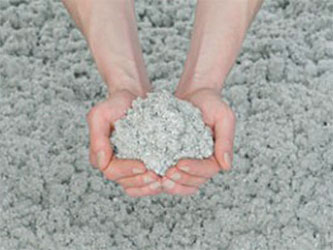Cellulose thermal insulation
 Cellulose thermal insulation is in the form of fine flakes made from sorted paper blasted to the prepared structure.
Cellulose thermal insulation is in the form of fine flakes made from sorted paper blasted to the prepared structure.
The sorted paper is coarse-torn, mixed with mineral salts and dry shredded. Such formed flakes are resistant against fire, rodent and insect attack, mould and rot.
The fibrous insulation works on the principle of micro-spaces filled with air entrapped amongst the fibres. Their thermal insulation quality depends upon the fine paper shredding with as high quantity of minute areas and fibres as possible, while the fibres may not be of too high thermal conductivity and they must be sufficiently long.
These properties of fibres can be achieved by using a special technology of turbine shredding that is fibre-friendly while preserving their original length to the maximum possible extent.
The blast insulation is suitable for thermal and acoustic insulation of walls, roofs and floors. It is extraordinary suitable for thermal insulation of complex areas when reconstructing or in new buildings. The insulation may be blasted also directly to the walls with an admixture of water. This way it may create up to 10 cm insulation layer or thinner acoustic surfaces suitable for interior.
Cellulose insulation advantages
The advantage of this fine structure is smaller depth venting of insulation in the case of vented structures, whereby the insulation properties shall be preserved alongside the entire structure depth.
A great phase shift after heat transition belongs to the further advantages of thermal insulation. In principle, when cellulose insulation is used it means the summer midnight sun heat would reach the attic area only after almost five hours , when the highest temperature is reached at the external side of the roof.
Cellulose insulation does not burn, its top layer just gets carbonised.

- good thermal insulation and sound-proof properties
- fast application
- possibility of quality filling of even more complex structural elements by continuous insulation without heat leaks
- diffusion permeability
- good humidity regulation, longer phase shift (delay with what the material or structure responds to the change in the external temperature)
- long life
- recycled raw material is use
- low strain on environment during its production
- may be recycled by combustion at high temperature. It is ideal to suck up the old insulation and subsequently recycle it
What should be paid attention to ?
The professional application is crucial in order to avoid possible flaws.
For the sake of dusting down the fine fibres it shall be necessary to avoid the direct contact with interior or provide with a paint if in the blasted form.
 Cellulose thermal insulation is in the form of fine flakes made from sorted paper blasted to the prepared structure.
Cellulose thermal insulation is in the form of fine flakes made from sorted paper blasted to the prepared structure.